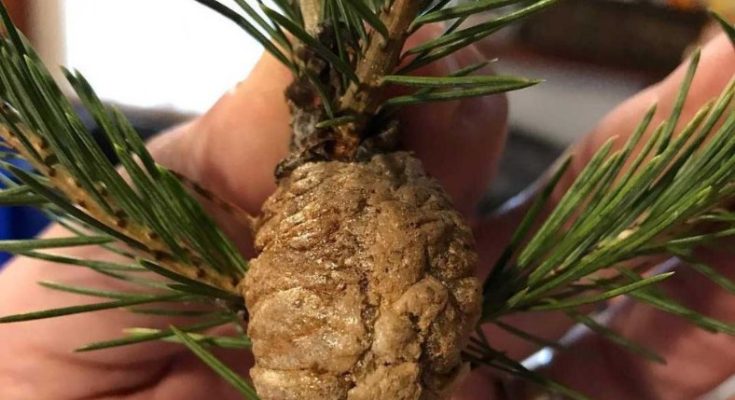The holiday season is a time for joy, decorating homes with sparkling lights, festive ornaments, and of course, the beloved Christmas tree. But for one man, what was meant to be a cheerful Christmas tradition took a surprising twist when he discovered something unusual hidden among the branches of his freshly decorated tree. This discovery led to a social media post warning others about a hidden aspect of holiday trees that many might overlook: praying mantis eggs. Let’s dive into this unexpected encounter and explore why it’s important to inspect your Christmas tree before bringing it indoors.
The Unexpected Encounter: Praying Mantis Eggs on a Christmas Tree

As the man adjusted the ornaments on his newly-acquired Christmas tree, he noticed a strange brownish mass attached to one of the branches. Upon closer inspection, he realized that the mass wasn’t just a random clump of pine needles or tree sap—it was an egg case, also known as an ootheca, from a praying mantis. In his Facebook post, he shared his discovery with others, urging them to check their trees carefully for similar surprises.
In his post, he wrote, “If you happen to see a walnut-sized/shaped egg mass on your Christmas tree, don’t fret, clip the branch and put it in your garden. These are 100-200 praying mantis eggs! We had two egg masses on our tree this year. Don’t bring them inside—they will hatch and starve!”
What Are Praying Mantis Egg Cases?
The egg case discovered on the tree was not just an oddity—it was a protective structure called an ootheca, where a praying mantis lays its eggs. These cases are typically brown or tan, foam-like in texture, and can contain dozens to hundreds of eggs. The ootheca acts as a natural incubator, providing a safe space for the eggs to develop through the colder months. As spring approaches and the temperatures rise, the young mantises hatch and begin their journey into the world.
While the ootheca may look like an unusual mass on your tree, it’s not harmful to your decorations. However, the real concern is what happens when the eggs hatch indoors, which is why it’s crucial to be aware of what you might be bringing into your home.
How Do Praying Mantis Eggs End Up on Your Christmas Tree?
It might seem strange to find praying mantis eggs on a Christmas tree, but it’s actually a common occurrence. Christmas trees, often harvested from tree farms, are naturally homes for various insects and wildlife, including the praying mantis. These insects typically lay their eggs on tree branches during late summer or fall. When these trees are cut down, shipped, and sold as Christmas trees, the egg cases can inadvertently make their way into homes.
During the holiday season, many people unknowingly bring these egg cases inside, where they remain hidden until spring. This can result in an indoor hatching event, with young mantises dispersing in search of food.

What Are the Risks and Benefits of Praying Mantis Eggs Indoors?
The idea of tiny mantises hatching and crawling around your living room might seem unsettling, but the truth is that praying mantises are generally harmless to humans and pets. In fact, they are considered beneficial insects because they help control pest populations, including flies, mosquitoes, and aphids. A small number of mantises could actually contribute to your home’s natural pest control.
However, there are a few practical concerns. If the mantises hatch indoors, they will likely scatter in search of food, which could lead to a rather messy situation. The young mantises might end up in places where they’re hard to find, and if they don’t have access to food, they may not survive long. For this reason, it’s better to prevent them from hatching inside.
Steps to Safely Handle and Remove Praying Mantis Eggs
If you discover an egg case on your Christmas tree, don’t panic. The good news is that there are simple steps you can take to safely remove the eggs and ensure that they hatch in the right environment.
- Locate the Egg Case: First, carefully locate the ootheca on your tree. It’s often walnut-sized and might be nestled deep within the branches.
- Gently Remove the Branch: Once you’ve found the egg case, gently clip the branch or cut the portion of the tree that holds it. Be careful not to damage the eggs in the process.
- Place the Eggs Outside: Take the egg case and place it in a sheltered area outside, such as a garden or on another tree. This gives the mantises the space they need to hatch and begin their life cycle naturally.
By removing the eggs and placing them outside, you’re helping to protect both your home and the local ecosystem. The mantises will hatch and find plenty of insects to feast on outdoors, without creating a mess inside.

The Importance of Inspecting Christmas Trees Before Bringing Them Indoors
To avoid any surprises like this one, it’s essential to inspect your Christmas tree carefully before bringing it indoors. While the majority of Christmas trees won’t come with praying mantis eggs, it’s always best to check for unusual masses or structures on the branches. Here’s a quick checklist to help you with the inspection:
- Look for unusual masses: Check for any walnut-sized or foam-like structures on the tree branches.
- Give the tree a gentle shake: This can help dislodge any hidden insects or egg cases that may be clinging to the branches.
- Examine the trunk and base: Don’t forget to check the base of the tree, as insects can sometimes hide in the lower branches.
Taking these simple precautions can help you avoid the surprise of finding mantis eggs or other hidden creatures in your living room.
Raising Awareness: How Sharing the Experience Helps Others
The man’s decision to share his experience on social media was a reminder of the power of online communities in raising awareness. His Facebook post quickly gained traction, as many people expressed surprise at the discovery and appreciation for the warning. Sharing experiences like this can help others avoid similar situations and promote a better understanding of the natural world and the wildlife that shares our environment.
Conclusion: A Natural Surprise During the Holidays
While discovering praying mantis eggs on a Christmas tree may not be part of the typical holiday experience, it serves as a reminder of the hidden connections between our celebrations and the natural world. By taking simple steps to inspect and handle these egg cases responsibly, we can coexist with nature while still enjoying the festive cheer of the season. After all, life finds a way—even among the twinkling lights and shiny ornaments of a Christmas tree



